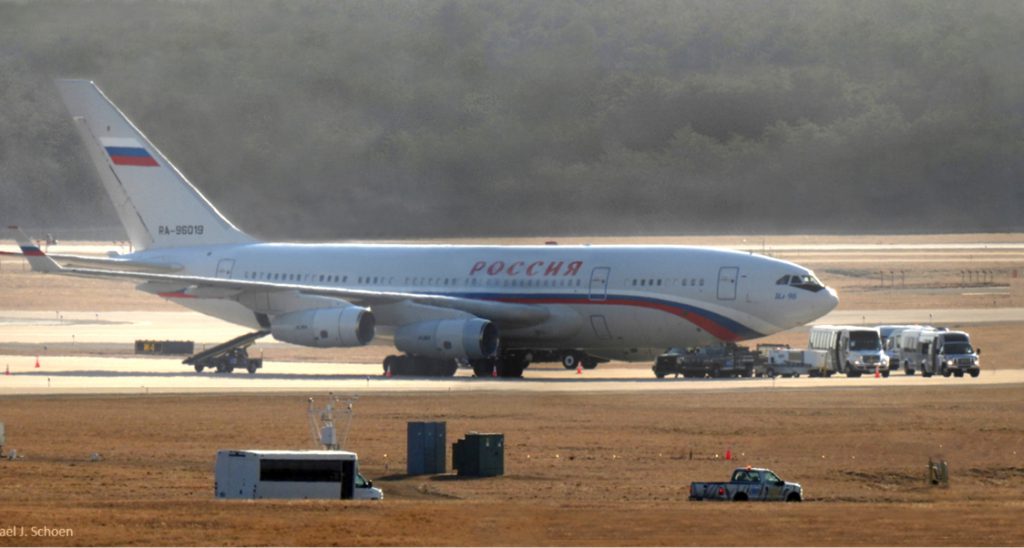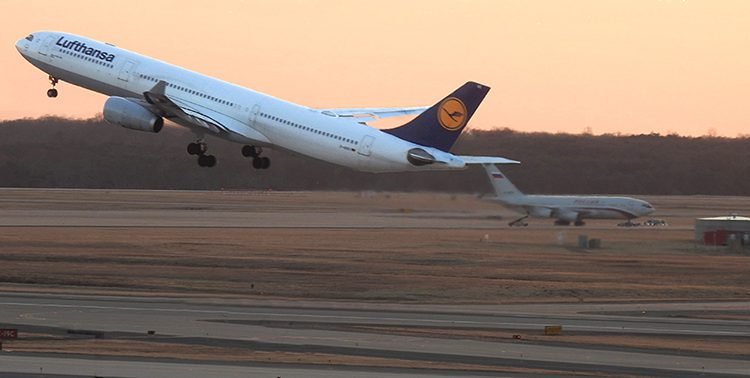Photo above – In the background: A Russian-built jet banished to a tiny, isolated apron at DC’s Dulles International Airport.
Story and photo by Michael J. Schoen
I rent a priceless, ever-changing piece of aviation art: the picture window in my apartment. It overlooks Washington, DC’s Reagan National Airport. The Pentagon and its helipad are across the street from me. On the other side of the Potomac River, I can see the South Lawn “helipad” at the White House. “Andrews Air Force Base” is just over the tree line. A little further out is a glide path to Baltimore-Washington International airport. If you look slightly upwards you can see a departure route from Washington’s international airport: Dulles. And far above it all is a high-altitude jet route, along which airliners fly at 30,000 feet. If their beautiful contrails were infinite, you would see them stretching back to airports all over the country, and the world.
On January 11th I was delighted when my plane-spotting app alerted me to something I’d never before seen in my airspace: a Russian airliner was passing overhead. It was cruising at 37,000 feet, enroute from Moscow to Miami. Like so many Russian-operated airliners, it was a Western-built jet. Specifically, it was an Airbus A350, as I could clearly see with the help of my camera’s zoom lens. Russia was one of the countries whose aircraft I had never before seen. So, I was quite excited!
One month later, I had an even rarer treat. On February 11th, a Ukrainian-built, Russian-operated Antonov An-124 freighter passed by, high overhead. There are several reasons why it was truly a joy to see that massive, four-engine jet: The An-124 is rare; something I’d been hoping to see for a long time. It was also my first glimpse of an aircraft that wasn’t built in the West. And finally, there was the hopeful, political symbolism of a Ukrainian-built, Russian-operated aircraft.

A few days later Russia invaded Ukraine. Soon after, Russian aircraft were banned from U.S. airspace, perhaps forever. Nonetheless, last Saturday morning the aviation-aficionado community was abuzz with the news that a Russian-government jet was inbound for Dulles. And not just any jet: it was a four-engine, Russian-built Ilyushin Il-96 airliner; one of a handful that are said to transport Russia’s President and other high-ranking officials.
At first, many of us hoped that this was a diplomatic mission; an olive branch. But no. The U.S. was expelling a number of Russian diplomats, and the Ilyushin was reportedly coming to take them home, along with their families and belongings.
I drove out to Dulles, for my first good look at at a widebody airliner that wasn’t built by Boeing or Airbus. The best place to see it was from atop Parking Garage #2. Upon arriving, I was surprised to find at least a dozen members of the press, with their TV cameras trained on the Ilyushin.
It was parked by itself, on a lonely, isolated apron, amidst the vast, one-mile expanse of fields and woodlands between Runways 1C/19C and 1L/19R. No terminal. No jet bridge. Just a small entourage of a few shuttle vans, airline-food service trucks, and a mobile baggage loader.
Over the next few hours, we watched as colorfully-painted Boeings, Airbuses, Embraers, and other Western-built jets came and went. These international-airline flights were bound for, or arriving from, airports all over the world. Except Russia and Ukraine. Meanwhile, the Ilyushin’s entourage had left, and the aircraft sat alone; cut off from the hustle and bustle of international commercial flights that were arriving and departing all around it. I couldn’t help but find the aircraft’s extreme isolation as being symbolic of Russia’s current relationship with the rest of the world.



